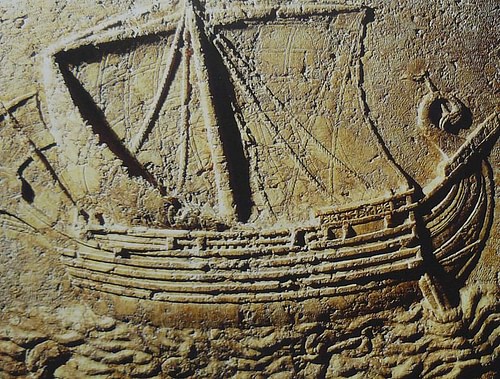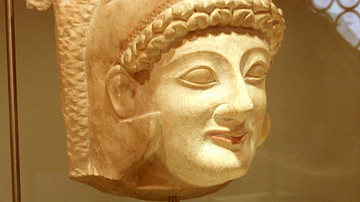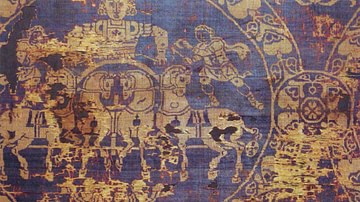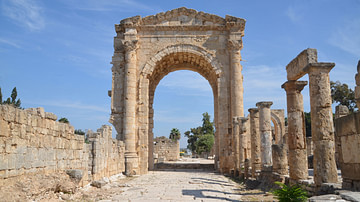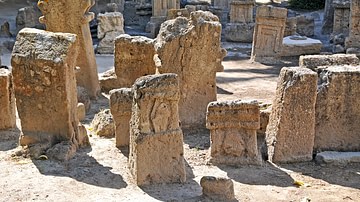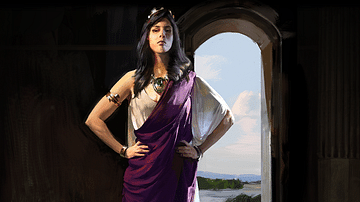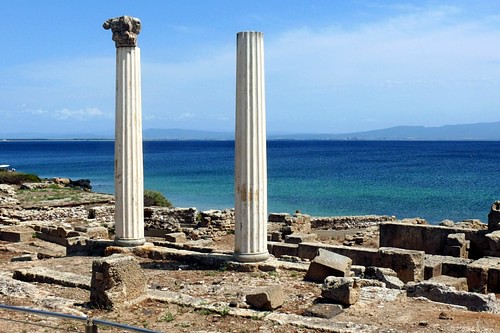
The prosperity of Phoenician cities such as Tyre, Sidon, and Byblos was based on trade, and it was the search for new commodities and new markets which resulted in the Phoenicians branching out from the narrow coastal strip of the Levant and colonizing territories throughout the ancient Mediterranean from the 10th century BCE.
Some of the Phoenician colonies, like Leptis Magna, Cadiz, and Palermo, became important cities in their own right, and none more so than Carthage on the north coast of Africa, which would eventually outshine its mother city of Tyre and create an empire of its own.
From Trading Posts to Colonies
The Phoenicians were great traders and great navigators, and this combination of skills almost inevitably resulted in them establishing colonies wherever they went. The major Phoenician trade routes were by sea to the Greek islands, across southern Europe, down the Atlantic coast of Africa, and up to ancient Britain. In addition, Arabia and India were reached via the Red Sea and vast areas of Western Asia were connected to the homeland via land routes where goods were transported by caravan.
Trade and the search for valuable commodities (for exchange, for tribute to Assyria, and also for use in the thriving Phoenician manufacturing industry) necessitated the establishment of permanent trading posts. Further, as the Phoenician ships generally (but certainly not always) sailed within sight of the coast and only in sailed in the daytime, regular way-stations were required too. These outposts, originally chosen for their safe and shallow harbours and proximity to fresh water, became more firmly established in order to control the trade in specific commodities available at that specific site. More permanent settlements could also become a valuable new market in which to sell Phoenician manufactured goods and would better protect the Phoenician's long-term business interests. In time these sites developed further, their population became more permanent and larger, their architecture more substantial, and so on, until they became full colonies and large cities in their own right.
The Phoenicians' colonization of the Mediterranean was perhaps motivated more by commerce than territorial expansion for its own sake, but that one led to the other seems inevitable. It is also true that the Phoenician homelands had shrunk following expansion by neighbouring powers and may also have been affected by climate change and a reduction in rainfall with a negative consequence on arable land and crop yields; a problem made worse by an ever-expanding population. Whatever the motivations, the result of this long process of colonization was a permanent Phoenician influence extending around the whole coastline of the Mediterranean.
Dating the Process
According to ancient writers, Phoenician colonization began from the 12th century BCE, but some modern historians consider this too early a date and suggest the process was contemporary with Greek colonization in the 8th century BCE. Still other scholars suggest that Phoenician contact with many sites must have been earlier than this and cite such facts as the passing on of the Phoenician alphabet to the Greeks, references in the Bible to sailing vessels of Tyre in the 10th century BCE, a reference in a 10th century source from Tyre to a colony not paying its tribute (either Utica or more likely Cyprus), and the unanimity of ancient writers that Phoenician colonization of the Mediterranean occurred before the Greeks. It is also true that the first primitive trading posts are unlikely to have left much in the archaeological record so that scholars looking for physical evidence of colonization prior to the 8th century BCE are severely challenged to find it.

A compromise has, therefore, been achieved amongst scholars which posits a period of 'pre-colonial' trade centres established between the 12th to 8th centuries BCE, followed by the establishment of colonies proper between the 8th and 6th centuries BCE. In this period then, lasting over 500 years, the Phoenicians controlled a network of stopping points which established them as one of the greatest trading powers in the ancient world. Between these colonies, Phoenicia itself, and the great civilizations of the period goods were shipped and exchanged such as textiles, glass, papyrus, precious metals, wood, wool, pottery, foodstuffs, spices, and slaves.
Cyprus & the Islands
The geographical proximity of Cyprus probably meant it was one of the first places to be colonized by the Phoenicians, perhaps as early as the 11th century BCE. Resources on the island which motivated Phoenician expansion included timber and copper. The most important city was Kition but others included Golgoi, Idalion, Tamassos, Marion, and Lapethos. Other islands in the Aegean which were colonized include Rhodes (Camiros and Ialysos), Crete (Itanos), Kythera, Melos, Thasos, and Thera.
North Africa
Phoenicia had always had strong trade links with Egypt and trading posts were probably established there as early as anywhere else. Further along the northern coast of Africa with its fertile soil and access to interior trade goods such as ivory, the ancient sources state that Utica was established in c. 1101 BCE by Sidon. Carthage, according to the same authors, was founded in 814 BCE by Tyre. Other colonies were Auza (mentioned in texts as founded by Tyre but of unknown location), Leptis Magna, Hippo, Hadrumetum, and Lixus. When Carthage prospered and grew into a large city in its own right, it started to found colonies too, and this second wave has caused some confusion amongst historians (ancient and modern) regarding dates and who exactly founded what.
Italy
Sicily was colonized by the Phoenicians, although they withdrew to the western part of the island when challenged by the Greeks. Cities such as Motya, Panormo (modern Palermo), and Solunto were founded from the 8th century BCE. At the same time, colonies were established on the strategically important islands of Lampedusa, Malta, and Pantelleria. Again, just how much a role Carthage played in this process is debated amongst historians. Further west, Sardinia (rich in cereals) was colonized earlier, probably in the 9th century BCE with its important cities being Nora, Caralis (Cagliari), Bythia, Sulcis, Carloforte, and Tharros.
Spain
In antiquity, Spain was a rich source of silver which the Phoenicians were able to trade from indigenous peoples for relatively low-value goods such as glass, oil, and pottery. Ancient sources state that Gades (Cadiz) was established in c. 1110 BCE but the evidence is scant for such an early date and the subject controversial. Nevertheless, Tarshish (Tartessus) of Biblical fame, whose identity is unknown (and actually may not be a city name at all), was perhaps somewhere north of Gades, and likely, along with that city, founded in the 10th century BCE. Other important Phoenician colonies were Malaka (modern Malaga), Sexi (Almunecar), Abdera (Adra), and Ebusus (Ibiza). The latter, long-thought to have been a Carthaginian colony, shows evidence of an earlier Phoenician settlement.
Relationship with the Homeland
The colonies established by the Phoenicians would vary in their proximity to the home territory's own culture and practices depending on their geographical location and the strength of the indigenous culture already present. North Africa became, perhaps, more 'Phoenician' than any other territory. Elements of the Phoenician religion were adopted, gods such as Melqart and Astarte were worshipped, in time temples, sanctuaries, and cemeteries were constructed, and religious practises and festivals were carried out just as they were in the home cities of Tyre or Sidon. One of the most consistent Phoenician features found at colonies was the Tophet, the sacred precinct built outside a city where sacrifices were carried out, including children by fire (perhaps only in exceptional circumstances).

Phoenician art was another export, physical pieces but also ideas and methods. Workshops were established at colonies which could produce the fine goods, such as goldwork and purple-dyed cloth the homelands were so famous for. Architecture too was copied from the homeland, such as the temple of Melqart at Gades whose layout and columns mirrored those of the temple at Tyre.
If religion and art came in one direction, then raw materials and tributes went in the other. Each year Carthage had to send tribute, one-tenth of its yearly profits, to the Temple of Melqart at Tyre. As the colonies prospered so they expanded their territory, an action perhaps not unrelated to their population growth. They became more militarized, built fortifications, and fought with indigenous peoples or competing regional powers. They were now cities in their own right and fighting for their place in the ancient world.
Legacy
The Phoenician colonies eventually became either absorbed by local cultures or contemporary civilizations keen to expand themselves. For example, Cyprus was conquered by the Assyrian king Sargon II at the end of the 8th century BCE, Nebuchadnezzar besieged Tyre in the early 6th century BCE, and the Greeks became more ambitious in their own colonial expansion, forcing the Phoenicians to relinquish their influence in parts of Magna Graecia. And as we have already seen, some colonies became so successful that they founded colonies of their own, in the case of Carthage from the mid-6th century BCE, even embarking on military campaigns to forge for itself an empire and take control of former Phoenician colonies. The power and influence of Phoenicia itself fell away even further following the attack of Alexander the Great in 332 BCE but it had by then, through its ambitious and daring establishment of colonies, already significantly contributed to a much more connected Mediterranean world.
